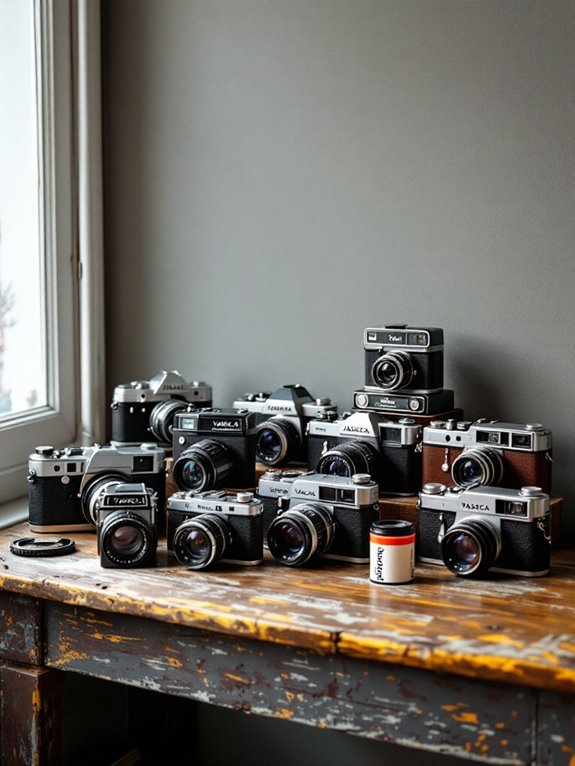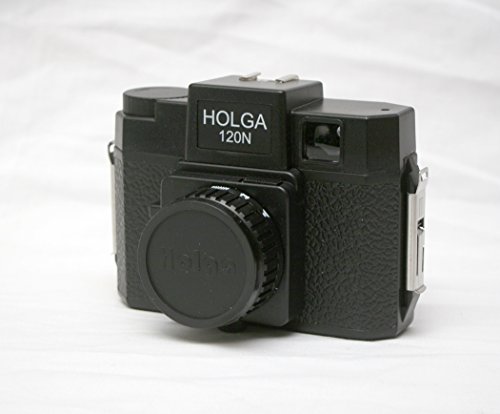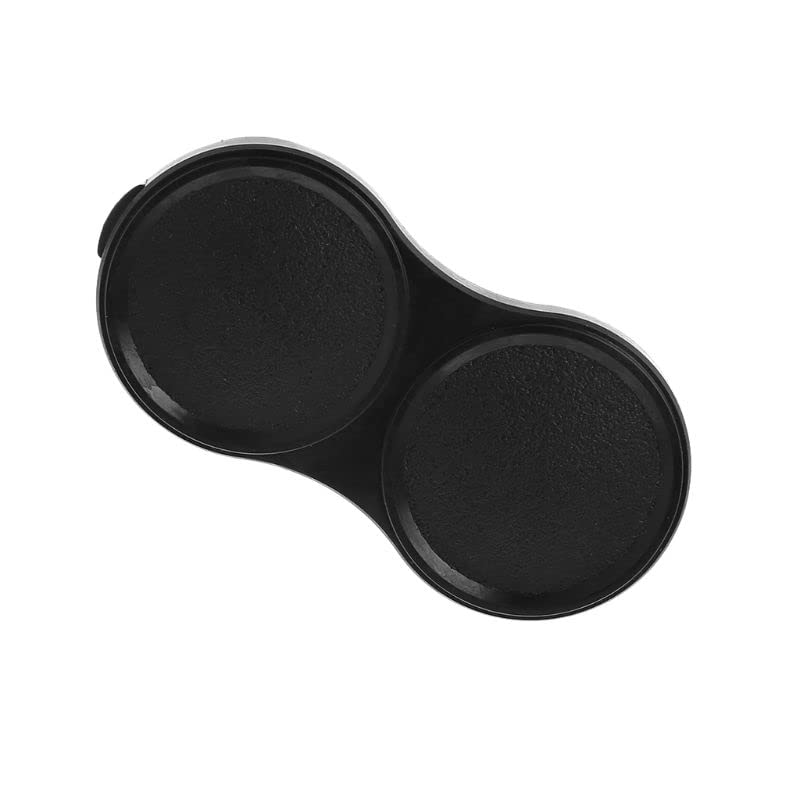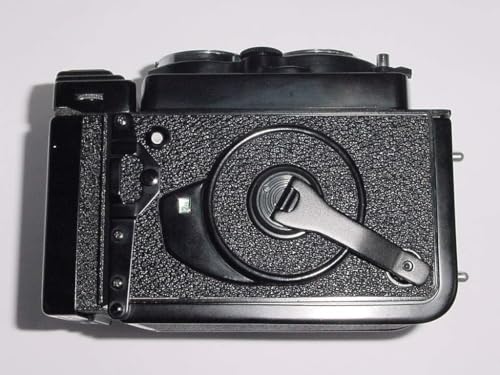Vintage photography enthusiasts seeking Yashica twin lens cameras should consider the Yashica Mat 124G TLR, featuring a Yashinon 80mm f/3.5 lens that delivers Hasselblad-comparable image quality. This medium format camera offers functionality with minor limitations such as a non-working frame counter. Alternatives include the Mint instantflex TL70, which combines classic TLR aesthetics with modern Instax Mini film capability. Accessories like the Twin Lens Cap Replacement protect valuable optical elements, while the Holga 120N provides an artistic alternative with distinctive vignetting effects. Further exploration reveals additional models with unique specifications and performance characteristics.
Key Takeaways
- Yashica Mat 124 G TLR features a sharp Yashinon 80mm f/3.5 lens and produces image quality comparable to Hasselblad cameras.
- Twin lens cameras like the Mint instantflex TL70 blend vintage aesthetics with modern instant film technology for immediate results.
- Medium format twin lens reflex cameras deliver 6×6 square format images with unique depth and character sought by vintage enthusiasts.
- Yashica twin lens cameras typically offer reliable mechanics, ground glass focusing screens, and waist-level viewfinders for distinct shooting experience.
- The Holga 120N serves as an affordable alternative in the twin lens category, producing artistic vignetting and soft focus effects.
Fujifilm Soft Shutter Button for Canon Nikon Leica Cameras
- Camera Button Accessories: Compatible with Fujifilm camera series X100VI, X100V, X100F, XT5, XT4, XT3, XT2, XT30, XT20, XT10, XE4, XE3, XE2, XPRO3, XPRO2, XPRO1, Nikon ZF...
- Photographer Camera Accessories: The Qiang Ni camera button is made of pure copper, with a concave design, perfectly complementing your favorite camera and providing the...
- Fuji Shutter Button: Each package includes 2 camera buttons, each shutter button comes with a rubber ring to cushion and stabilize.Making every press of the shutter a...
The Fujifilm Soft Shutter Button represents an essential accessory for photography enthusiasts seeking to enhance their shooting experience with Yashica Twin Lens cameras and numerous other compatible models. This precision-engineered component, measuring within a package of 6.57×4.09×1.02 inches and weighing 0.704 ounces, features a pure copper concave design with knurled edges for improved tactile feedback.
Compatibility extends across multiple camera systems, including Yashica SLR series, with users reporting a notably improved shooting experience. The button, which installs easily by screwing clockwise into the original camera slot, stabilizes finger pressure during operation. Customer satisfaction metrics confirm its value, with 425 users awarding it 4.6/5 stars and noting the concave shape provides enhanced control without requiring modifications in most applications.
Best For: Photographers looking to enhance the tactile experience and shooting stability of their compatible Fujifilm, Nikon, Leica, Canon, Sony, and other branded cameras including the Yashica SLR series.
Pros:
- Made of pure copper with a concave knurled design that improves grip and shooting experience
- Easy installation by simply screwing clockwise into the original camera shutter button slot
- Compatible with a wide range of camera models across multiple brands, with package including two buttons and rubber rings
Cons:
- May require modifications with a rotary tool for proper fitting on some camera models
- Limited color options compared to what some photographers might prefer
- Higher price point compared to standard shutter buttons, prompting some customer price feedback reports
Holga 120N Plastic Camera
- 2 film masks for either 12- 6x6 cm images or 16- 6x4.5cm images
- Shutter Speeds: (N)ormal - 1/100s; (B)ulb - Holds Shutter Open
- Apertures: SUNNY - f/11; SHADE/FLASH - f/8
Medium format enthusiasts seeking artistic imperfections will find the Holga 120N Plastic Camera a compelling alternative within the Yashica twin lens lineup. This all-plastic medium format camera delivers deliberate technical flaws—soft focusing, vignetting, and light leaks—that create distinctive aesthetic qualities.
The 120N offers practical versatility with dual film masks (12-6x6cm or 16-6×4.5cm frames), two aperture settings (f/11 for sunny, f/8 for shade/flash), and two shutter speeds (1/100s and bulb mode). Focus zones are simplified to four distances: one person, three people, group, and mountains. The hot shoe adapter accommodates external flash units, while the 1/4-20 tripod mount enables long exposures essential for low-light conditions.
Best For: Creative photographers and medium format enthusiasts who value artistic imperfections, spontaneity, and the unique aesthetic qualities of lo-fi photography over technical precision.
Pros:
- Creates distinctive images with dreamy soft focus, vignetting, and light leaks that digital filters struggle to authentically replicate
- Lightweight, compact design with versatile format options (6x6cm or 6×4.5cm) makes it ideal for travel and street photography
- Simple operation with minimal settings encourages mindful shooting and artistic experimentation at an affordable price point
Cons:
- Inconsistent quality control with some units suffering from manufacturing defects requiring DIY fixes with electrical or gaffer tape
- Extremely limited technical control with only two aperture settings and unreliable viewfinder that doesn’t accurately represent the final image
- Learning curve can be frustrating for beginners as achieving good results requires understanding the camera’s limitations and quirks
Twin Lens Cap Replacement for Rolleiflex, Minolta, Autocord and Yashica Cameras
- Made from high quality materials, it is anti-impact, heat-proof, durable and dust-proof.
- Lens mount cap covers the rear mount of your lens when not in use.
- Protects the rear glass element and electronic contacts from scratches, dust, water, and fingerprints.
Protecting your valuable twin lens camera system requires specialized caps designed specifically for models like the Yashica 124, Rolleiflex, Minolta Autocord, and similar TLR cameras. EILRUSH’s replacement caps, constructed from impact-resistant plastic, shield delicate optical elements and electronic contacts from dust, water, and fingerprints.
The caps measure 83mm (3.27in) in length with overall dimensions of 3.07in × 2.99in × 0.75in, weighing just 0.317 ounces. Compatibility extends across multiple TLR cameras, though Yashicamat 124G owners should note that minor filing might be required for proper fit around the camera’s knobs and dials. Introduced in October 2023, these caps currently hold a 3.6/5 star rating from users.
Best For: Photographers with twin lens reflex (TLR) cameras including Rolleiflex, Minolta Autocord, Yashica 124, and similar models who need reliable protection for their camera’s optical elements.
Pros:
- Lightweight and compact design makes it easy to carry in a camera bag
- Durable anti-impact and heat-proof material provides complete protection against dust, water, and fingerprints
- Universal fit works with multiple TLR camera brands and models
Cons:
- Requires filing for proper fit with Yashicamat 124G camera knobs and dials
- Limited user reviews (only 4 ratings) make reliability assessment difficult
- Higher price point compared to some alternative lens cap options
Yashica Mat 124 G TLR Medium Format Vintage Film Camera with 80mm Lens
- leather case included
Vintage photography enthusiasts and medium format film aficionados will find the Yashica Mat 124 G TLR an exceptional choice, combining remarkable mechanical reliability with outstanding image quality. This 6×6 format camera features a Yashinon 80mm f/3.5 lens that delivers impressive sharpness, with users reporting results comparable or slightly superior to Hasselblad images.
The camera’s mechanical functions perform flawlessly after testing, with a functional light meter using a fresh 1.5v battery, though a 1.3v Weincell battery is recommended for original voltage specifications. Cosmetically, it maintains excellent condition with minimal brassing at high points and no fungus, haze, or separation in the glass elements.
Best For: Vintage photography enthusiasts, film students, and professional photographers seeking a reliable medium format camera with exceptional image quality comparable to high-end systems at a more accessible price point.
Pros:
- Produces remarkably sharp images with the Yashinon 80mm f/3.5 lens, with some users reporting results comparable or even superior to Hasselblad cameras
- Fully functional mechanical systems and light meter, having been completely tested and verified to be in working condition
- Excellent cosmetic condition with only minor signs of wear, making it both a functional tool and a collectible piece
Cons:
- Frame counter doesn’t work according to user feedback, requiring manual tracking of exposures
- Viewing glass contains some smudges and particles that may be distracting but don’t affect final image quality
- No parallax correction built in, requiring users to learn how to compensate when framing close-up subjects
Mint instantflex TL70 Instant Camera for inxtax Mini Instant Film
- Classic style instant film camera with Twin Lens Reflex design.
- Large variable aperture f/5.6-f/22, 61mm fixed focal length main lens (f/2.9-f/11.8 32mm equivalent in 35mm) with focus range from 48cm to infinite. The lens also...
- Fresnel ground-glass focusing screen with magnifying lens for precise focusing. The camera also features a secondary line-of-sight viewfinder.
Photography enthusiasts seeking a blend of nostalgic design and modern functionality will find the Mint instantflex TL70 a remarkable innovation in the instant camera market. This pioneering twin lens reflex instant camera combines classic TLR aesthetics with contemporary capabilities, delivering 46x62mm images on Fujifilm Instax Mini film.
The TL70 features a 61mm lens (32mm equivalent) with multiple aperture settings from f/5.6 to f/22, plus a special bokeh option. Manual focusing ranges from 48cm to infinity, utilizing a Fresnel ground-glass screen with magnifying lens. Advanced exposure controls include aperture priority (1/500s-1s), Bulb mode (up to 10s), multiple exposure capability, and ±1 EV compensation, delivering precise control typical of professional equipment rather than instant cameras.
Best For: Photography enthusiasts who appreciate vintage aesthetics and want creative control over their instant photography with professional-level features in a unique twin lens reflex design.
Pros:
- First-of-its-kind twin lens reflex instant camera offering manual focusing, multiple aperture settings, and exposure controls typically found in professional cameras
- Compatible with widely available Fujifilm Instax Mini film, providing immediate tangible prints with 46x62mm image size
- Advanced creative features including multiple exposure capability, Bulb mode up to 10 seconds, and a special bokeh aperture setting
Cons:
- Steep learning curve for users unfamiliar with manual camera operations and twin lens reflex systems
- Some users report issues with focus alignment and print defects requiring practice to master
- Higher price point and larger size/weight (525g) compared to simpler instant cameras on the market
DEVMO DIY Camera Kit Compatible with Retro Holga Lomo Recesky TLR (2 PCS)
- ★The Recesky DIY Twin Lens Reflex (TLR) Camera is a beautiful DIY (Do-It-Yourself) camera that represents everything that is lomo. We ly love the idea of a camera that...
- ★ Going through the process of assembling the camera is not only a joy in itself, but allows you to ultimately understand the exact function that every part ultimately...
- ★The TLR stands for Twin Lens Reflex. There are two lenses - one for capturing the photo onto film, and the other that acts as as a viewfinder for framing the photo....
This DIY twin lens reflex camera kit offers an ideal entry point for hobbyists and photography enthusiasts who enjoy hands-on projects with functional results. The package includes two complete TLR camera kits with assembly requiring approximately one hour per unit, utilizing the included Chinese-English instructions without needing additional cutting tools.
The camera’s specifications deliver surprisingly capable performance, featuring a compact body (6.3 x 4.33 x 0.59 inches) weighing 315g with strong low-light capabilities. Operation follows traditional TLR methodology, utilizing one lens for image capture on 35mm film (ISO200 recommended) while the second serves as a viewfinder. Construction materials consist primarily of durable black cardstock and plastic components, requiring careful handling during assembly to prevent breakage of smaller elements.
Best For: Photography enthusiasts aged 14+ who enjoy DIY projects, have patience for detailed assembly work, and appreciate the unique aesthetic of lomography-style film photography.
Pros:
- Includes two complete DIY camera kits that offer both an enjoyable assembly experience and functional twin lens reflex cameras
- Compact and lightweight design (315g) with strong low-light capabilities and traditional TLR operation
- No cutting tools required for assembly, making it accessible for hobbyists with basic screwdrivers
Cons:
- Assembly includes tiny parts that can be difficult to install, potentially frustrating for younger users or those with poor fine motor control
- Instructions have language barriers with Chinese-English manual that may be difficult to follow
- Potential for light leaks and internal reflections that can affect photo quality without proper debugging
LUBITEL 166 Universal Medium Format TLR Film Camera
The LUBITEL 166 Universal stands out as a versatile option for photographers seeking affordable entry into medium format twin lens reflex photography without Yashica’s price premium. This LOMO-manufactured camera (formerly GOMZ) offers dual-frame capability, allowing you to shoot in both 6×6 cm and 6×4.5 cm formats when using the appropriate mask.
For best results, you’ll need the black lower and transparent upper mask pieces when shooting in 6×4.5 cm mode. The camera features a focal plane viewfinder and comes with Cyrillic or Roman alphabet logos. When purchasing, request specific photos from sellers to confirm included accessories: lens cap, cable release, and the essential 6×4.5 cm mask, as many listings omit important details.
Best For: Film photography enthusiasts looking for an affordable entry point into medium format photography who enjoy the vintage aesthetic and don’t mind manual operation.
Pros:
- Offers versatile dual-frame capability (6×6 cm and 6×4.5 cm formats) increasing shooting flexibility
- Significantly more affordable than comparable Yashica TLR cameras while providing similar functionality
- Durable construction from the LOMO factory with accessories like lens cap and cable release available
Cons:
- Often sold without complete accessories, particularly the essential 6×4.5 cm mask needed for dual-format shooting
- Requires manual operation and additional equipment (tripod, cable release) for optimal long-exposure results
- Vintage nature means most units available are used and may have condition issues requiring research before purchase
Yashica DigiPix 100 Digital Camera with 16X Zoom (White)
- VINTAGE-STYLE SHOTS: Capture fun, nostalgic photos up to 44MP and record videos in 1080P, 720P, or 480P with this classic digital point-and-shoot camera. Ideal for...
- POWERFUL 16X DIGITAL ZOOM: Get close to your subject with the 16X digital zoom. This old school digital camera is ideal for shooting distant landscapes, wildlife, or...
- LIGHTWEIGHT AND TRAVEL-FRIENDLY: Weighing only 256g with the battery, this photography camera is lightweight and easy to carry. It is small enough to fit in your...
Modern photography enthusiasts seeking a blend of vintage aesthetics with digital functionality will find the Yashica DigiPix 100 an impressive contender in the point-and-shoot category. This compact camera, weighing just 256g, captures 44MP photos in JPG format and videos at 1080P, 720P, or 480P resolution.
The DigiPix 100 features a 16X digital zoom, f/7.36mm focal length, and F/3.2 aperture. You’ll appreciate its 2.4-inch 320×240 IPS display and user-friendly controls. Power comes from a rechargeable 700mAh Li-Ion battery, while storage utilizes Micro SD cards up to 64GB. The camera’s portable dimensions (94x24x58mm) make it ideal for travel photography.
Best For: Entry-level photographers, teenagers, and casual users seeking an affordable, lightweight camera with vintage styling for everyday adventures and travel documentation.
Pros:
- Compact and lightweight design (256g) makes it highly portable for travel and everyday use
- Impressive specifications for its price point, including 44MP photos and 1080P video capability
- User-friendly interface with simple controls makes it accessible for photography beginners
Cons:
- Limited aperture (F/3.2) may result in suboptimal performance in low-light conditions
- Digital zoom rather than optical zoom can degrade image quality when zooming in significantly
- User feedback indicates potential quality concerns with contrast, saturation, and exposure
Sakar 75-300mm f5.6 One-Touch Lens for Yashica Manual 35mm Film Camera
- Manual 35mm Film Camera
Photographers seeking versatile telephoto capabilities for their Yashica manual 35mm film cameras will find the Sakar 75-300mm f5.6 One-Touch Lens an economical addition to their kit. This Chinese-manufactured lens, measuring precisely 9 × 2 × 2 inches, offers an impressive zoom range that’s particularly suitable for portrait, wildlife, and sports photography applications.
The lens features one-touch zoom and focus control, streamlining your shooting workflow when capturing fast-moving subjects. Market data indicates moderate popularity, ranking #419 in Point & Shoot Film Cameras since its January 2023 release. Compatibility with Yashica’s manual 35mm systems makes this lens a practical choice for photographers exploring telephoto options without significant investment.
Best For: Budget-conscious photography enthusiasts using Yashica manual 35mm film cameras who need a versatile telephoto zoom lens for portrait, wildlife, and sports photography without a significant investment.
Pros:
- One-touch zoom and focus control allows for quick adjustments when capturing fast-moving subjects
- Impressive 75-300mm focal range provides excellent versatility for telephoto photography
- Compact dimensions (9 × 2 × 2 inches) make it relatively portable considering its zoom capabilities
Cons:
- Maximum aperture of f5.6 is relatively slow, limiting performance in low-light conditions
- As a budget option, optical quality may not match premium telephoto lenses
- Manufacturing in China may indicate potential quality control or durability concerns compared to higher-end alternatives
Medium Format Vintage Film Camera with 80mm Lens for Yashica Mat
- 80mm Lens: Provides sharp and high-quality images with beautiful depth of field, ideal for portrait and landscape photography.
- Medium Format Film: Uses 120/220 film, offering greater image quality and detail than 35mm film for a richer, more dynamic look.
- Twin-Lens Reflex Design: Features two lenses for capturing images, one for viewing and one for taking the photo, allowing for precise composition and framing.
Serious collectors and professional portrait photographers will find exceptional value in this medium format vintage film camera with its 80mm lens specifically designed for Yashica Mat models. The system’s compatibility extends across the 124G, 124, LM, TLR, 635, and 2.8F C330 variants, ensuring broad application within the Yashica ecosystem.
This TLR configuration employs dual-lens architecture—one for viewing, one for capture—delivering precise composition control. The 80mm lens produces exceptionally sharp images with distinctive depth of field characteristics, particularly suited for portraiture and landscape work. The camera accepts both 120/220 film formats, yielding substantially higher resolution and tonal range than standard 35mm systems, while maintaining the authentic film aesthetic that digital capture cannot replicate.
Best For: Vintage photography enthusiasts, professional portrait photographers, and serious collectors seeking high-quality medium format film images with the distinctive aesthetic and technical advantages of a twin-lens reflex system.
Pros:
- Compatible with multiple Yashica Mat camera models (124G, 124, LM, TLR, 635, and 2.8F C330), offering versatility for Yashica enthusiasts
- 80mm lens delivers exceptionally sharp images with beautiful depth of field characteristics perfect for portrait and landscape photography
- Produces higher resolution and greater detail than 35mm film systems through the use of 120/220 medium format film
Cons:
- Manual controls require technical knowledge and experience for proper exposure settings
- Currently unavailable for immediate purchase as the first availability date is listed as March 7, 2025
- Film photography workflow is more time-consuming and costly than digital alternatives, requiring film purchase and development
Factors to Consider When Choosing a Yashica Twin Lens Camera
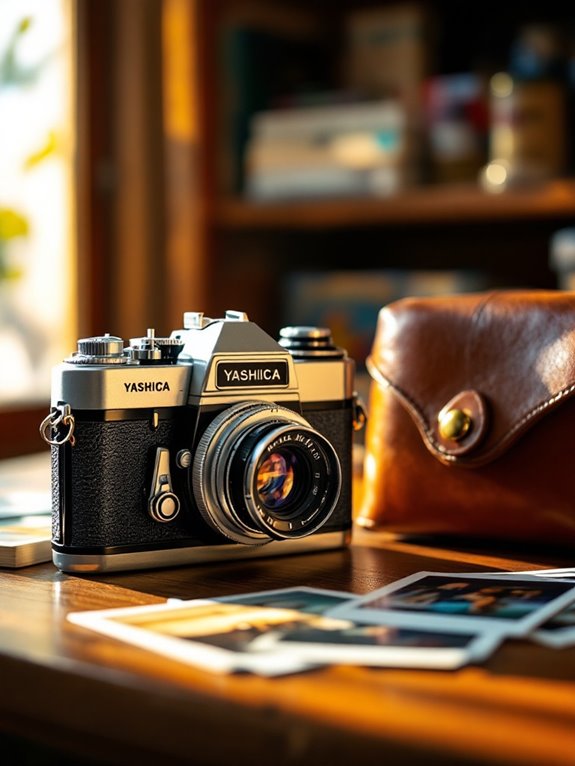
Selecting the appropriate Yashica twin lens camera requires evaluation of several critical factors, including film format compatibility, optical performance, and long-term mechanical durability. The camera’s lens quality, characterized by coating technology, maximum aperture, and edge-to-edge sharpness, greatly impacts image resolution and overall photographic results. Ergonomic considerations, coupled with light meter functionality and accuracy, further differentiate models within the Yashica TLR lineup, ultimately determining both operational efficiency and image-making potential.
Film Format Options
The film format compatibility of Yashica twin lens reflex cameras represents one of the most critical considerations for photographers evaluating these classic medium format systems. Yashica TLRs primarily utilize 120 medium format film, delivering the standard 6×6 cm square negative that yields 12 exposures per roll. This format provides substantially higher resolution and tonal range compared to 35mm film, making these cameras ideal for portrait and landscape work requiring exceptional detail.
Select Yashica models accommodate format variations through specialized inserts, enabling 6×4.5 cm exposures that increase frame count to 16 per roll. More advanced Yashica TLRs feature 220 film compatibility, doubling potential exposures to 24 frames at 6×6 cm, though this requires proper pressure plate adjustment mechanisms. The square format characteristic of most Yashica TLRs offers compositional flexibility unavailable in rectangular formats.
Lens Quality
Beyond film format considerations, lens quality stands as a primary determinant of image performance in Yashica twin lens reflex cameras. Yashica’s Yashinon and Tessar-type lenses, typically ranging from 75mm to 80mm focal lengths, demonstrate variable optical performance across different models.
Higher-end Yashica models feature multi-coated glass elements that effectively minimize flare and chromatic aberrations, particularly in high-contrast shooting scenarios. The maximum apertures, ranging from f/2.8 to f/3.5, determine low-light capabilities, with earlier models generally offering inferior light transmission coefficients compared to later versions. Resolution characteristics, measuring between 40-50 line pairs per millimeter in premium models, directly correlate with image sharpness and microcontrast. Metal lens barrels with precise helicoid focusing mechanisms provide superior durability and consistent performance compared to plastic housing variants found in budget models.
Mechanical Reliability
Mechanical reliability forms the cornerstone of long-term satisfaction with any Yashica twin lens reflex camera, requiring careful evaluation before purchase. The shutter mechanism demands thorough inspection for smoothness and consistency, as erratic operation directly impacts exposure accuracy and image quality. Aperture blades must remain free of oil contamination, which frequently causes sluggish response and irregular light transmission.
Film advance systems in Yashica TLRs require particular scrutiny, with well-maintained models exhibiting smooth, positive indexing without hesitation or grinding sounds. Internal gearing components, especially in the focus mechanism, often reveal premature wear in heavily used specimens. Critical inspection points include the body’s structural integrity and the lens board alignment, which must maintain precise parallelism between taking and viewing lenses. Deterioration in these areas manifests as inconsistent focusing accuracy and image sharpness degradation over extended use periods.
Design and Ergonomics
Discerning photographers evaluating Yashica twin lens reflex cameras must consider the interplay between design elements and operational comfort, which directly impacts shooting efficiency and image quality. The waist-level viewfinder configuration characteristic of these models reduces neck strain during prolonged shooting sessions, allowing for more stable handheld operation.
Yashica’s ergonomic implementation typically positions manual focus and exposure controls within intuitive reach, permitting precise adjustments without disrupting composition. Weight distribution across the camera body serves to enhance stability during operation, while textured grip surfaces contribute to secure handling in various shooting environments. The compact dimensions of most Yashica TLR models—notably the Yashica Mat series—facilitate extended field use without inducing fatigue, a critical consideration for documentary and street photography applications where mobility remains paramount.
Light Meter Function
The built-in light meter functionality stands as a critical evaluation criterion when selecting a Yashica twin lens reflex camera, particularly for photographers seeking accurate exposure without relying on external metering devices. Battery voltage greatly impacts meter accuracy, with the recommended 1.3v cells aligning precisely with original design specifications to deliver consistent readings across varying lighting conditions.
Photographers utilizing 1.5v batteries may experience operational functionality but should anticipate potential sensitivity alterations resulting in exposure compensation requirements of approximately +0.5 to +1 stop. Regular voltage testing becomes essential for maintaining ideal meter performance, as degradation below manufacturer thresholds can introduce progressive measurement inaccuracies. Models with well-preserved light meter circuitry provide reliable ambient light measurement capabilities, supporting exposure determination from EV 4 (indoor, low light) to EV 16 (bright sunlight), effectively accommodating most photographic scenarios.
Vintage Vs Modern
When evaluating Yashica twin lens cameras, photographers face significant operational differences between vintage and contemporary models that directly impact shooting methodology and resulting image characteristics. Vintage Yashica models feature fully mechanical operations requiring manual focusing and exposure calculations, which develop technical skill but demand greater expertise and time investment. These traditional models utilize medium format film, producing superior negative size and potential image resolution at the cost of extended processing workflows.
Modern Yashica variants incorporate electronic automation systems for exposure control and focusing assistance, reducing technical barriers while sacrificing the tactile engagement many enthusiasts value. Contemporary models may feature compatibility with instant film or digital back attachments, offering immediate image review capabilities absent in vintage counterparts. Construction materials differ substantially between eras, with vintage cameras typically employing metal components for longevity while modern versions prioritize lightweight composites for improved portability.
Frequently Asked Questions
How Difficult Is It to Find Film for Vintage Yashica TLR Cameras?
Finding film for vintage Yashica TLR cameras presents moderate challenges today. These cameras typically use 120 medium format film, which remains in production from manufacturers like Kodak, Fujifilm, and Ilford. Specialty photography stores and online retailers regularly stock this format, though at higher prices ($8-15 per roll) than in previous decades. Color options have decreased substantially since 2000, with approximately 75% fewer varieties available compared to the format’s heyday.
Can Yashica TLR Cameras Be Repaired if the Mechanics Fail?
Yashica TLR cameras can indeed be repaired when mechanical failures occur. Specialized repair technicians with expertise in vintage cameras typically address common issues including shutter mechanism malfunctions, focus rack problems, and mirror alignment failures. Parts availability varies greatly by model, with components for popular versions like the Yashica Mat-124G being more accessible than those for obscure models. Repair costs generally range from $150-$300 depending on failure complexity, parts requirements, and technician expertise.
What’s the Average Price for a Well-Maintained Yashica Mat 124G?
While collectors dream of bargain-basement prices, reality presents a different financial landscape. The Yashica Mat 124G typically commands $300-$500 in well-maintained condition on secondary markets. Prices vary based on several factors: functioning light meter (+$50-100), original case inclusion (+$30-50), lens clarity (fungus-free glass essential), and overall cosmetic condition. Fully serviced examples with warranty documentation from reputable camera technicians frequently reach the upper pricing threshold, occasionally exceeding $600 for mint specimens.
Are Light Meters in Vintage Yashica TLRS Still Accurate Today?
Light meters in vintage Yashica TLRs often require recalibration due to component degradation over time. Selenium-based meters found in early models typically lose sensitivity, while CdS meters in later models like the 124G may remain functional if battery compartments are corrosion-free. Accuracy deviation commonly ranges from 1-2 stops, with selenium meters showing greater inconsistency. Professional recalibration services typically cost $75-150, though many photographers opt for external light meters for critical exposure determination.
How Do Yashica TLRS Compare to Rolleiflex in Image Quality?
“The proof is in the pictures,” as photography enthusiasts often say. Yashica TLRs deliver respectable image quality with sharp center resolution (approximately 40-50 line pairs/mm), though they generally fall short of Rolleiflex’s superior optics. Rolleiflex cameras, featuring Zeiss and Schneider lenses, consistently achieve higher resolution (60-70 lp/mm), better contrast, and superior color rendition. Yashica models, particularly the 124G with its Yashinon lens, represent excellent value despite exhibiting more noticeable corner softness and chromatic aberration than their premium counterparts.

